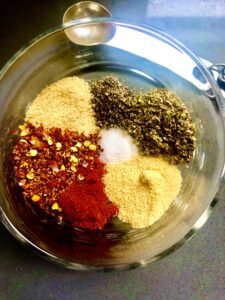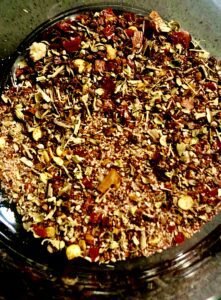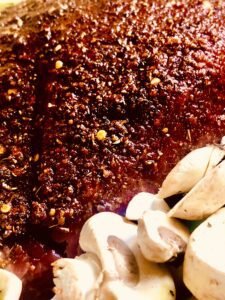KETO LOW-CARB ROAST BEEF SPICE RUB (HEART HEALTHY)

WHAT IS THE NUTRITIONAL VALUE OF BEEF?

I have pernicious anemia and so require sufficient doses of vitamin B-12 through food, vitamins, and shots. Once in a while, I crave beef. The fact is beef contains high-quality protein and nutrients like Creatine and Carnosine, which are important for our muscles and brain.
We have a hefty beef farming industry in our community in Ontario, Canada. We also have very cold winters. Around the world, there is much controversy over this term called ‘grass-fed.’ In our community cows are generally fed grass in the summer and finished on corn before processing.
Organic Farms:
However, we also have a few organic farms. A local organic beef farmer feeds his cattle summer grass and in winter the cattle consume hay and legumes. The legumes are grown in the field with the grass and so are mixed when the hay is harvested and wrapped. (Finishing is a term used to describe the time that the cattle are fattened before processing).
I learned that cattle finished on corn and/or grain and given hormones can have a daily weight gain of up to three pounds. Finishing on corn gives the beef more fat marbling. Cattle finished on hay and legumes are generally smaller animals that gain about one pound in weight per day.
As a food writer aiming to please my guests when entertaining, I’ve always advocated for cattle finished on corn because this method provides the beef with more marbling, and therefore fatter, and therefore more flavor. And my adage has always been, “Where there’s no fat, there’s no flavor.”
I love marbling! I’ve embraced and implemented grass-fed beef into our diet.
Dr. Mody Levy:
My naturopathic doc, who also happens to be a medical doc, Dr. Mordy Levy (Toronto, Canada) advocates the consumption of organic, grass-fed beef on occasion and in moderation. Every country has its own ideas and regulations about cattle feeding. I was told by this organic farmer that in Canada we have no organization advocating for organic, grass-fed cattle.

In the United States, cattle grazed on grass for the first six months to a year of their lives, but then are finished at a feedlot. The cattle spend anywhere from 60 to 200 days at the feedlot where they are fed a concentrated combination of corn, soy, grains, supplements, as well as hormones and antibiotics. Those in this industry may refer to this as a ‘balanced ration for optimum weight.’
During the 200 days at a feedlot, the cattle gain as much as 400 pounds. If a cow can gain three pounds of fat per day and you multiply this by 200 days, it’s easy to understand how this much weight can be acquired over 200 days. Once the cattle are fattened to their ‘finished weight’ they are transported to the slaughterhouse.
American Grass Fed Beef Association:
As per the American Grass Fed Beef Association, “an animal’s nutrient profile can significantly change during those months of grain finishing, with levels of important nutrients like CLA and Omega-3 fatty acids decreasing dramatically in the animal’s tissues.”
This is a crucial consideration when incorporating beef into your diet. I prioritize providing my husband and myself with natural forms of Omega-3s for our overall health.
I firmly believe that the treatment and diet of cows impact the nutritional value of beef, a sentiment echoed by many scientists (though not all, as some farmers and scientists hold opposing views). Everyone has the right to their opinion.
As I understand it, cows naturally graze on grass, influencing their digestive tract, PH levels, and the fatty acid composition of the meat.
The Mayo Clinic:
As stated in an article by Dr. Rekha Mankad, M.D. on the Mayo Clinic website, “grass-fed beef may offer heart-health benefits not found in other types of beef.” Dr. Mankad further explains that grass-fed beef may contain less total fat, higher levels of Omega-3 fatty acids, increased conjugated linoleic acid (which is thought to reduce risks of heart disease and cancer), and greater amounts of antioxidant vitamins like vitamin E.
Red meat contains three primary types of saturated fat: stearic acid, palmitic acid, and myristic acid. Grass-fed beef tends to have higher proportions of stearic acid, which does not elevate blood cholesterol levels.
Whenever possible, purchase beef directly from farmers to observe firsthand how the animals are raised and treated.
WHAT IS THE TASTE PROFILE OF KETO ROAST BEEF SPICE RUB?
The predominant taste sensations of this Keto Roast Beef Spice Rub are salty and spicy. These qualities will nicely offset sweet potato or butternut squash.
WHAT NON-ALC WINE HARMONIZES WITH KETO ROAST BEEF SPICE RUB?

The predominant taste sensations of this Keto Roast Beef Spice Rub are salty and a smidgen of heat from the chili peppers. Normally you would need a non alcoholic wine with some sweetness to offset the heat from the chili. But in following a Keto diet or in living a low-carb lifestyle, we don’t want to use up carbs on a glass of wine with carbs. So, you have a couple of options. Drink whatever non-alc wine you like (as long as it’s bone dry) and don’t worry about pairing the wine to the dish. Enjoy your non alcoholic wine the way you like it. If you like to create harmony between the wine and the food, you’ll need some sweetness in the wine to offset the heat. Add a pinch of monk fruit sweetener to your glass of rose wine. Why rose? Because NA white wine generally doesn’t work well with beef. And you certainly don’t want to add sweetener to a beautiful red!
Remember the old adage “red wine with red meat?” Pairing sweetness from the dish with a bone dry red with hefty tannin won’t work well. This sweetness will clash with the tannin in the non alcoholic wine. As a result the wine’s acidity will be offensive and taste like pain thinner. Adding a pinch of monk fruit sweetener to a big red won’t taste good either.
So, rose it is in this case! Rose can be enjoyed bone dry or tastes great with sweetness. And it has enough weight to stand up to the weight of beef. So choose a bone dry NA rose and add a pinch of monk fruit sweetener.
ZERO ALCOHOL WINE TIPS:
ALCOHOL AND KETOSIS:
To support your Keto diet or low-carb lifestyle, opt for quality, non-alcoholic wines that are low-carb and low in sugar. Additionally, alcohol does not align with a keto diet or low-carb lifestyle. Moreover, your liver processes alcohol before nutrients, pausing ketone creation and slowing the ketosis process. Furthermore, your body will metabolize alcohol as fuel before utilizing food, which can decelerate fat burning and may lead to the storage of carbs, fat, and protein as excess body fat. Moreover, alcohol consumption stimulates the appetite, potentially causing overeating.
ALCOHOL AND HEALTH:
Did you know that when you consume alcohol, your liver has to work extra hard to break it down? This can result in damage to your liver. Furthermore, it can elevate your risk of health issues such as inflammation and cancer, particularly with heavy consumption. Additionally, alcohol can disrupt your blood sugar levels, leaving you feeling dehydrated and disrupting your body’s normal functions.
NON-ALCOHOLIC WINE AND HEALTH BENEFITS:
Non-alcoholic wines with minimal carbs and sugar are advantageous for your health. They not only aid in weight management, blood sugar control, and hydration but also contain essential nutrients and antioxidants from grapes that can decrease your risk of health conditions like heart disease. Consequently, since they lack alcohol, they’re ideal for socializing without any adverse effects, promoting feelings of happiness and reduced stress.
WHAT OTHER KETO LOW-CARB HEALTHY HEART RECIPES CAN I ENJOY?

Keto Low-Carb BLT Tart
Steak Marinade (Heart Healthy)
Cinnamon Marmalade Chicken (Heart Healthy)
WHAT EQUIPMENT DO YOU NEED TO PREPARE THIS RECIPE?
Equipment Needed:
- Oven-safe roasting pan or baking dish
- Mixing bowl
- Measuring spoons
- Basting brush (optional)
- Meat thermometer
- Carving knife
HOW DO YOU PREPARE KETO ROAST BEEF SPICE RUB?

Combine all spices in bowl.

Mix rub ingredients together.

Coat beef in rub. Set in a oven-proof pan. Add vegetables of choice to the pan. Drizzle veggies with olive oil and season with salt and pepper. Roast for anywhere from 35 to 50 minutes to the desired doneness. Let roast rest for about 10 to 15 minutes. Slice and serve. Medium rare (35 to 45 minutes); Medium (45 to 50 minutes); Well done (50 to 60 minutes). Let rest for 10 minutes. Slice and serve.

KETO LOW-CARB ROAST BEEF SPICE RUB
- Total Time: 55
- Yield: 2.5 lb roast (serves 6) 1x
- Diet: Gluten Free
Description
Keto Low-Carb Roast Spice Rub uses ingredients you already have in your kitchen cupboard. The recipe uses paprika, cracked black pepper, onion powder, garlic powder, oregano, chili flakes, and olive oil. The combinations of these flavors in the rub tastes delicious on roast beef. If you are hunting for a highly flavourful roast beef dry rub check out this recipe!
Ingredients
1 teaspoon smoked paprika
1 teaspoon freshly ground black pepper
1 teaspoon onion powder
1 teaspoon garlic powder
1 teaspoon dried oregano
1/2 teaspoon dried chili flakes
2 tablespoons olive oil
1 (2.5 pound) grass-fed sirloin beef roast
Instructions
- Preheat oven to 325 F. Place all spice ingredients in a glass bowl. Mix well. Add olive oil to make a paste. Spread mixture over roast. (Add vegetables of choice to the roasting pan. Drizzle with olive oil and season with salt and pepper.) Roast for anywhere from 35 to 50 minutes to the desired doneness. Let roast rest for about 10 to 15 minutes. Slice and serve. Medium rare (35 to 45 minutes); Medium (45 to 50 minutes); Well done (50 to 60 minutes).
Notes
- The recipe is based on the keto version and is approximate only. One serving has 1 gram of net carbs.
- (Note: The nutritional information provided is a courtesy and is approximate only. We cannot guarantee the nutritional accuracy of any recipe on this site. We cannot now what brands you use or how accurately you follow the recipe or what you like to add creatively to the dish. Use the information as a general guideline only. Net carbs are the total carbs minus the fibre.)
- The recipe baking temperature and time is an estimate. Follow your own oven’s temperature and cooking time. It takes a gas oven 10-15 minutes to reach the desired temperature. Electric ovens can take 10 minutes longer than that. The age of your oven will also determine the temperature, time for roasting or baking, and where you want to place your dish in the oven. The bottom of your oven may be hotter than the top, depending on its condition. This also includes where to set your dish under the broiler. So use your own best judgment based on the type, condition, and age of your oven. Prep times will also vary depending on how slow or quickly you like to work.This recipe can be used to make one large bundt cake or made into muffins, using a 6 cup standard sized muffin tin.
- Prep Time: 5
- Cook Time: 50
- Category: KETO LOW-CARB
- Method: ROASTING
- Cuisine: DINNER
Nutrition
- Serving Size: 1
- Calories: 397
- Sugar: 0.3
- Sodium: 125
- Fat: 16.5
- Saturated Fat: 5.1
- Carbohydrates: 1.3
- Fiber: 0.4
- Protein: 57.6
- UNUSUAL KETO INSTANT POT RECIPES FOR 2025 - April 27, 2025
- Boost Your Keto Diet with These Non-Alcoholic Wine Hacks - April 27, 2025
- 10 Unique & Healthy Mocktails You Need to Try - April 27, 2025


